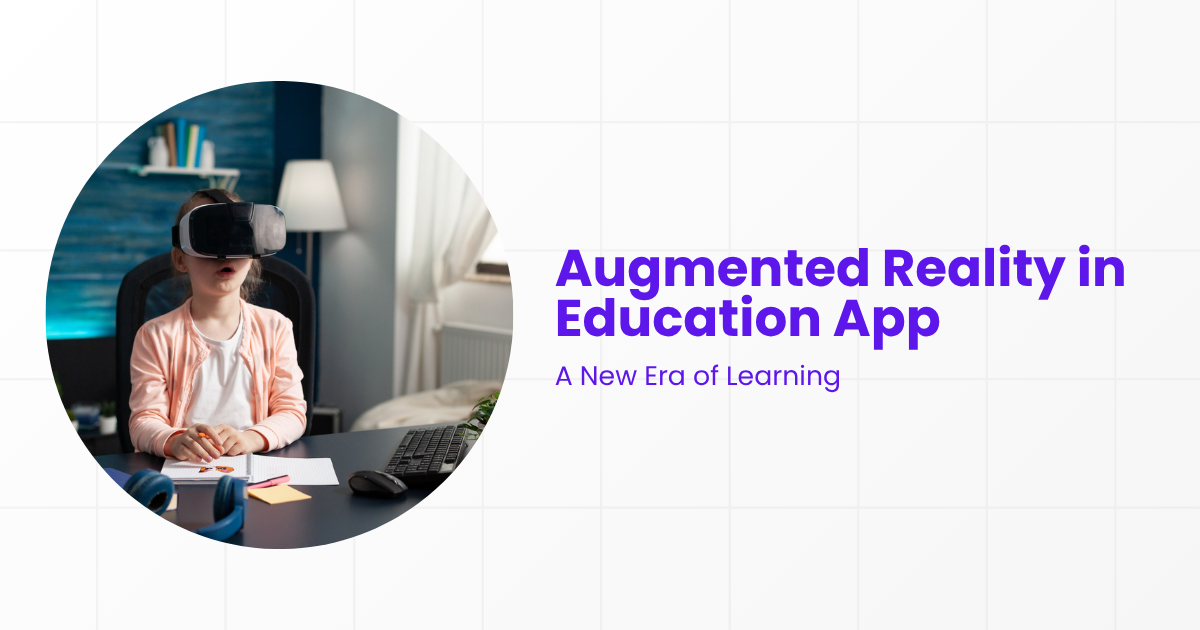Augmented Reality in Education App: A New Era of Learning
Technology has always played a crucial role in transforming Education. An initial move from chalkboards to computers, and then from...

Technology has always played a crucial role in transforming Education. An initial move from chalkboards to computers, and then from textbooks to eBooks, there has been constant evolution in the process of delivering education. Now in 2025, the next leap is being driven by Augmented Reality (AR), a transformative tool reshaping the scope of how students engage, learn, and retain knowledge.
AR is no longer a theory, it has found its way to classrooms with the rise in use of smartphones, tablets, and AR-enabled headsets. It is helping in making learning experiential, interactive, and impactful.
In this article, we will explore the role of AR in redefining the scope of education with its use cases, benefits, and what the future will look like.
But first,
What is Augmented Reality and its Role in Education?
Augmented reality works on enhancing the real-world environment by overlaying digital content, such as images, text, audios, or 3D models, on it. Unlike Virtual Reality (VR), AR does not replace the existing reality but adds to it.
For educational context, AR apps use a phone or tab’s camera to display additional content or information when aimed at real-world objects, books or flashcards. For example, when pointed out at a tree, it will tell the type of tree, fruits grown on it, color of the fruits, and more, basis on the information fed/requested.
This technology amalgamates concepts with visuals to create interactive learning experience and turning passive learning into active learning experience.
Role of AR in Education
Traditional learning methods are becoming outdated. Lectures, textbooks, and even rote memorization are failing to engage students. This is where AR is stepping in addressing these gaps.
- Improving engagement through gamification and interaction
- Simplifying complex concepts with the help of 3D visuals and animations
- Simulating real world environments to support experiential learning.
- Creating immersive experiences to enhance memory retention
- Utilizing self-paced AR modules to encourage independent learning
GenZ and Gen Alpha are growing in a digital native environment. And education must adapt to changes to keep them engaged. Let AI make learning feel like discovery, and not a chore.
How AR benefits Educational Apps Immensely
1. AR increases engagement and motivation
AR helps in making learning enjoyable. Whether it is about exploring the human body in 3D or stepping inside an ancient Roman empire, AR creates an environment that keeps students engaged for a longer period of time. This is why most education app development companies focus on integrating AR in any form to enhance the overall experience and business for its clients.
2. Simplifies abstract concepts with visualization
Subjects like mathematics, physics, or chemistry are often hard to understand with traditional tools. This is why even educators kept experimenting with new ideas to make the learning easy, but with AR tools coming into picture, they have immensely helped in turning complex concepts into simpler visuals, that are easy to grasp. For example, complex concepts like DNA replication or planetary motion can be turned into visual concepts that students can see and understand intuitively.
3. Tailored learning experience
AR apps are capable of adapting to individual learning style and speed. Students can explore and learn at their own pace without the pressure of pacing with an entire classroom.
4. Anytime, anywhere learning
With these mobile AR apps, learning is nolonger restricted to classrooms. Students can access AR-based applications and tools at home, or any other place, making education flexible and accessible for continuous support.
How You can Use AR in Education
1. Learning Languages
It is easy, hire app developers and get a learning app developed with AR flashcards and interactive word games to help students visualize vocabulary, listen to pronunciation, and easily associate with related objects in real time.
2. Understanding History and Geography
Time travel experiences through AR are helping students to virtually explore ancient civilizations or historical landmarks through apps and tools. Geography apps swiftly overlay maps, climates or terrain features to explain spatial details.
3. Bringing science and biology out the book
Augmented reality in education is helping in bringing biology to life for all science students. There are apps like Froggipedia that are helping students dissect a frog virtually, without having to harm the animal in reality. Other apps simulate molecular structures, space exploration, or chemical reactions, providing an incredibly dynamic learning experience.
Common challenges in Implementing AR in Education
AR in education is a promising, but complex process. As a business you should only partner with the best education app development company to swiftly overcome challenges mentioned below:
1. Constant development
High-quality AI content is time consuming and expensive to product. Furthermore, it requires educational alignment to ensure it fits within the ascertained curriculum standards.
2. Cost and scalability
Creating and maintaining an AR education platforms involves cost. Licensing, updates, and content expansion requires continuous investment in form of hiring app developers or companies.
Steps-by-step guide to help Startups Incorporate Augmented Reality in Education
If you are a startup founder eyeing on entering the education sector with augmented reality app, here is how you can kick start your journey.
- Find a real problem: check for existing gaps and problems in the current education setup that can be fixed with AR.
- Validate your idea: talk with teachers, students, and educational experts to get insights and their suggestions on your plan of action.
- Pick the right AR framework: with the help of your mobile app development company in the USA, choose the right platform to create your app, such as ARKit for iOS, ARCore for Android or Unity for cross-platform development.
- Build a pilot app: create a pilot app first to test its core features and test with real users.
- Ensure compatibility with curriculum: it is even more important when you are targeting your apps towards educational institutions.
- Consider making it more accessible: focus on making your AR app for education more accessible and affordable so that you can increase your customer base.
Also Read: Generative AI Integration Services: The Future of Smart Technology in Everyday Life
In the end,
Augmented reality in educational apps is more than just a tech trend. It is a revolution shaping the present and future of how education is provided. By making education experiential, AR is empowering learners like never before.






